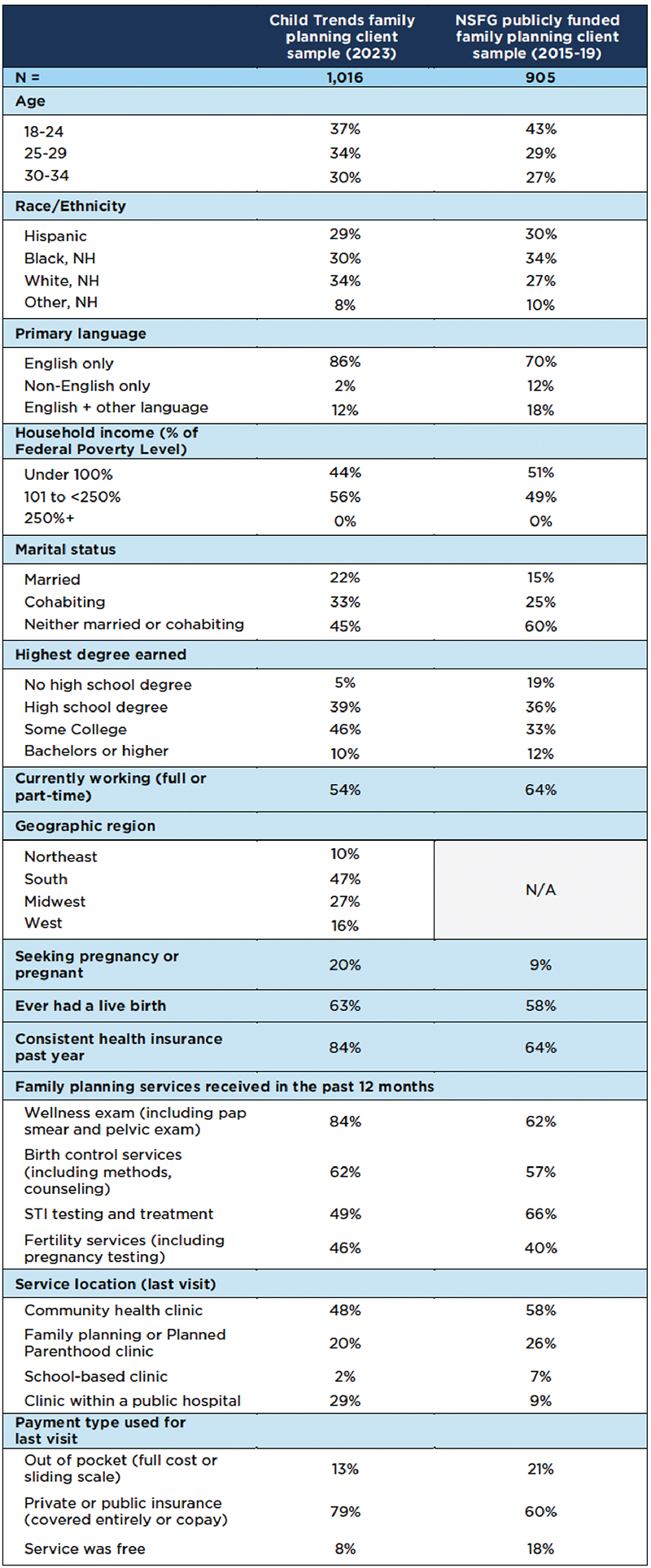Through a grant from the Office of Population Affairs (OPA), Child Trends is conducting the Equity-focused Strategies to Improve Family Planning Service Delivery project to help publicly funded family planning providers identify innovative and effective strategies to improve clients’ experiences—particularly for clients from populations that have been historically underserved by sexual and reproductive health care (SRH) providers. The Child Trends team is surveying and interviewing family planning clients and interviewing staff from Title X-funded health centers to identify clinic- and provider-level factors that shape clients’ care experiences and to gather insights on how providers can improve client experiences and advance equitable delivery of family planning services. This methods brief provides details on the client survey data collection effort.
Client Survey Design
The purpose of the client survey was to gather recent data on the family planning care experiences of clients across the country. We wanted to expand on data available in national datasets such as the National Survey of Family Growth (NSFG) and Family Planning Annual Report (FPAR) by diving deeper into clients’ experiences and views on what constitutes high-quality family planning care. We fielded the survey in September 2023, enrolling individuals from across the United States who had recently received family planning care and would be income-eligible for publicly funded services. We asked respondents about their most recent family planning visit in the past year (e.g., services received, location, payment used, use of telehealth), characteristics of that visit—including interactions with the provider (e.g., ratings of person-centeredness)—and other clinic factors (e.g., digital infrastructure, wait times, physical space). We also gathered information about previous sexual and reproductive health care visits that the respondent considered to be mostly negative or mostly positive experiences and any barriers or facilitators to receiving care. Respondents also reported on their socio-demographic information and contraceptive use.
Client Survey Fielding
To reach a large number of geographically diverse family planning clients, Child Trends partnered with Qualtrics, an enterprise survey technology solution and experience management platform with expertise in providing online samples. Qualtrics recruits from their actively managed online database of people who have agreed to be contacted to participate in research (totaling more than 250 million individuals), allowing them to find targeted samples. Child Trends validated Qualtrics’ sample of participants by reviewing participants’ addresses, checking for bots, using social media validation, and geolocating IP address, among other techniques.
Because we were unable to assess whether survey respondents had received care from a Title X-funded or other publicly funded family planning center,[1] our goal was to recruit a sample of respondents who had received family planning care in the past 12 months, would be income-eligible for publicly funded services, and received services outside of a private doctor’s office. We set eligibility requirements and quotas on key demographic characteristics so that our final sample would reflect Title X clients (based on data from the 2022 FPAR). Specifically, our sample was limited to respondents who:
- Female (86% of Title X clients are female).
- Were ages 18 to 34 (64% of Title X clients are in this age range).
- Had a family income less than 250 percent of the federal poverty line (FPL), the threshold for receipt of free or subsidized family planning services at a Title X clinic. Among Title X clients, 84 percent have incomes below this threshold.
- Received family planning services in the past 12 months from a community or public health clinic, a family planning or Planned Parenthood clinic, a school-based clinic, or a clinic within a public hospital. Family planning services included those covered by Title X funding:
- A wellness exam with a gynecologist or OBGYN
- Birth control services (e.g., methods, counseling)
- Assistance to achieve pregnancy, fertility services, or pregnancy testing
- Sexually transmitted infection (STI) testing or treatment
We set target quotas on the following demographics so that our sample better aligned with Title X clients:
- Hispanic (25% or more) and non-Hispanic Black respondents (25% or more)
- Marital status (less than 25% married)
Study Sample
Our target sample was 1,000 respondents. We successfully surveyed 1,016 respondents and reached our targets for race/ethnicity and marital status. Geographically, our sample distribution mostly aligned with the distribution of family planning users reported in the Family Planning Annual Report (FPAR). We compared the characteristics of our family planning client sample to National Survey of Family Growth (NSFG) respondents ages 18 to 34 with household incomes under 250 percent of the FPL and who received family planning services at a publicly funded site in the past 12 months, drawn from the most recent 2015 to 2019 data (see Appendix Table at end of brief). This analysis allowed us to understand how our sample compared to one that is drawn from a nationally representative survey and is confirmed to be clients of publicly funded family planning sites.
Client characteristics
Clients in our sample were similar to those in the NSFG in terms of age and race/ethnicity. There were small differences in marital/cohabiting status, educational attainment, employment status, and primary language. Compared to the NSFG, a higher proportion of family planning clients in our sample were married or cohabiting, had some college education, and only spoke English.[2] Additionally, a higher proportion of clients in our sample had consistent health insurance in the past 12 months (84%) compared to NSFG respondents (64%). Fewer clients in our sample were currently employed. Notably, a higher proportion of family planning clients in our sample were pregnant or seeking pregnancy (20% versus 9% in the NSFG), and 16 percent received prenatal care (not considered a family planning service under Title X) at their most recent visit (not shown). This flags that some analyses with this dataset (e.g., analyses of contraceptive use or experiences with contraceptive counseling) may need to be limited to only those receiving family planning services or those not pregnant or seeking pregnancy, depending on the research question.
Service receipt
Related to service location, a lower proportion of our sample reported receiving services at a community health clinic (48% versus 58% in the NSFG), and a higher proportion received services at a clinic within a public hospital (29% versus 9% in the NSFG).[3] Family planning clients in our sample generally received a similar set of services over the past year; however, a smaller percentage reported receiving STI testing or treatment (49% versus 66% in the NSFG), and a higher percentage reported receiving a wellness exam (84% versus 62% in the NSFG). Reflecting both location of services and higher rates of consistent insurance coverage, a higher proportion of our sample paid for their most recent family planning visit using insurance (79%) compared to respondents in the NSFG (60%). Fewer respondents in our sample paid out of pocket or received free services.
Conclusion
Overall, we succeeded in reaching a large, geographically diverse sample of young female family planning clients who were income-eligible for publicly funded family planning services. However, based on differences in services received, insurance coverage, and location of services compared to the NSFG, it is likely that our sample includes some respondents who accessed services at sites that were not publicly funded. The sociodemographic characteristics of our sample are similar to the sample of NSFG respondents who received family planning services at a publicly funded site in the past year. Based on these similarities, we are confident that findings from analyses of these data can help meet our project goal of understanding how Title X providers can improve client experiences and advance equitable delivery of family planning services.
Appendix
Table: Characteristics of Child Trends’ family planning client sample as compared to a sample of family planning clients from the National Survey of Family Growth, 2015-2019

Footnotes
[1] To do this, respondents would need to accurately record the location where they received services, and an intensive matching process against funding information would be required, which was beyond the scope of this project.
[2] The primary language finding likely reflects the fact that our survey was only available in English
[3] This difference could be a result of survey respondents not differentiating between public hospitals and non-profit hospitals (which are not publicly funded).
This publication was supported by the Office of Population Affairs (OPA) of the U.S. Department of Health and Human Services (HHS) as part of a financial assistance award totaling $1,548,353 with 100 percent funded by OPA/OASH/HHS. The contents are those of the author(s) and do not necessarily represent the official views of, nor an endorsement, by OPA/OASH/HHS, or the U.S. Government. For more information, please visit https://opa.hhs.gov/.
Suggested citation
Welti, K., & Manlove, J. (2024). Methodological approach to fielding a family planning client survey and resulting sample characteristics. Child Trends. DOI: 10.56417/5003q3593b

WANT MORE INFORMATION ON CHILD TRENDS' RESEARCH?
Sign up now
© Copyright 2025 ChildTrendsPrivacy Statement
Newsletter SignupLinkedInYouTubeBlueskyInstagram

